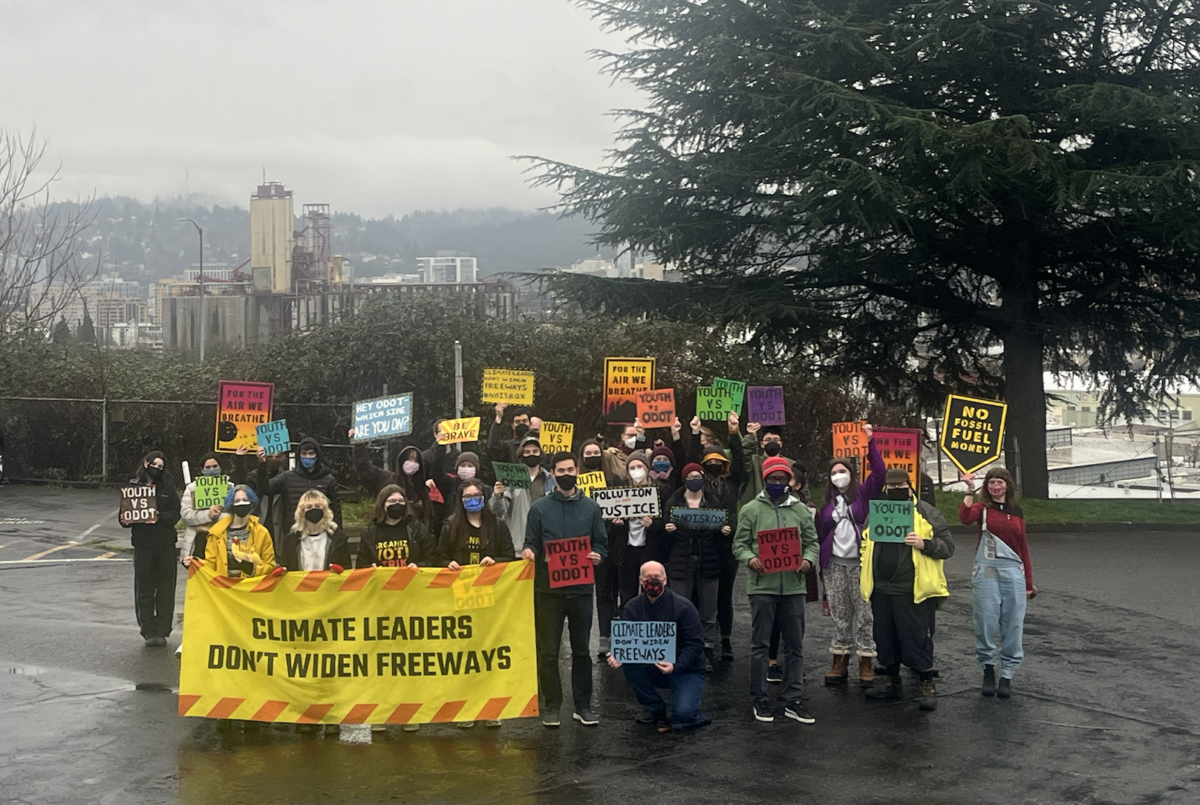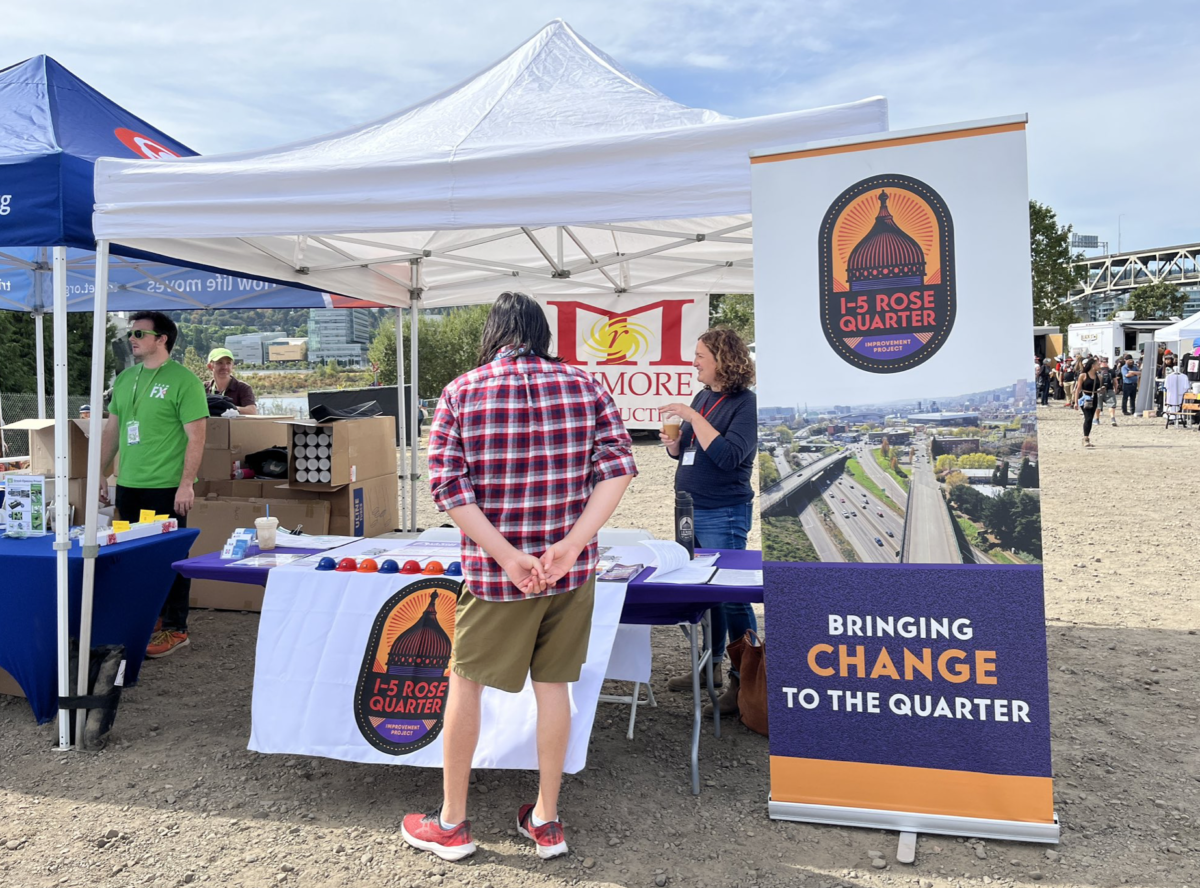
Now that the City of Portland and the Albina Vision Trust have both signed onto Oregon Department of Transportation plans to expand I-5 at the Rose Quarter it may seem like smooth sailing for the controversial project. And if Governor Kate Brown gets her wish, pro-freeway candidate Lee Beyer will be the next member of the Oregon Transportation Commission (OTC), which would give the project even more institutional support within the state legislature.
But it’s not exactly a well-paved road ahead. People who oppose the project aren’t going to back down, and there are some thorny issues left to navigate. Here’s a rundown of recent developments:
The Tubman Middle School dilemma

Last week, the Oregonian reported Portland Public Schools (PPS) has narrowed down its choices for where to relocate Harriet Tubman Middle School. The school currently sits adjacent to I-5 and ODOT’s project will bring lanes even closer to students’ lungs. Tubman Middle School (and its students and staff) has been a pawn in the freeway expansion plan and previous proposals for relocation have drawn a lot of ire.
PPS promised to keep the middle school within the current community boundaries, but it’s been difficult for them to find a suitable site. The two locations the district has its eye on now are: the Jefferson High School campus on NE Killingsworth Street and the current PPS headquarters located right across I-5 from Tubman’s current location.
According to The Oregonian, both of these potential sites have downsides. Adding a middle school to the Jefferson High School campus could result in problems for both middle and high schoolers, who would have to share a limited amount of athletic space. The Jefferson High School campus, located in the Humboldt neighborhood in north Portland, is also a mile and a half walk from Tubman’s current site. The PPS headquarters are much closer, but the location is surrounded by busy roads with equally toxic emissions with few pedestrian accommodations – plus this move would mean the PPS main offices would have to be relocated as well. Either way, the move may trigger another set of difficult and potentially unpopular decisions that ODOT will have to answer for.
Environmental review pressure
Meanwhile, anti-freeway activists continue to push ODOT to complete an Environmental Assessment for the project, which ODOT has attempted to avoid in the past. No More Freeways (NMF) is pushing the transportation department to complete a thorough Environmental Impact Statement (EIS) which includes a 90-day public comment period and public hearing as well as specific information omitted in previous environmental reviews. Last week, NMF and the Eliot Neighborhood Association sent ODOT a letter (PDF) asking them to share an update on their plans for the EIS.
“We are proactively reaching out to you now to ask for this full 90-day public comment period because the 45-day public comment period the agency provided in 2019 during the original Environmental Assessment (EA) was wholly inadequate. We wish to make explicit our desire that the full community, and not just ODOT’s hand-picked boosters, are given a fair and equal opportunity to weigh in about their concerns,” NMF wrote to ODOT.
The group posed several questions to ODOT about the EIS, including:
● Will ODOT commit to releasing all of the traffic modeling data used to produce traffic projections? If so, will ODOT commit to making the data promptly available in an electronic format?
● Will ODOT release detailed plans showing the actual dimensions of the proposed roadway and structures?
● Will ODOT provide a complete and detailed financial plan for the project showing the sources and uses of all funds, including potential toll revenues?
● Will ODOT’s traffic modeling include the impact of the Regional Mobility Pricing Program?
● Will ODOT’s traffic modeling rely on any assumptions, such as the existence of other yet to be constructed or approved projects (including but not limited to the Interstate Bridge)?
As far as we know, ODOT hasn’t yet responded to this email. According to the Rose Quarter project website, the supplemental environmental review process is nearing completion, but the department hasn’t provided an update on their progress since the federal government ordered them to complete a review last year.
ODOT: Everything’s fine!
ODOT is continuing their public relations campaign to rally support for the project. Representatives for the department tabled at the recent TriMet event celebrating the opening of the Division Street FX bus line and even handed out Rose Quarter expansion project-themed children’s activity books and crayons. (This was not received well by anti-freeway activists.)
Yesterday afternoon, ODOT’s Urban Mobility office sent a press release sharing results from a public opinion survey conducted over the summer (PDF), saying that more than 75% of 624 respondents across Multnomah, Washington and Clackamas counties support the project, with 30% “strongly” supporting the project. According to ODOT, survey respondents believe it’s a good idea to include shoulders and auxiliary lanes as a way to relieve traffic congestion.
ODOT shared supporter and opponent talking points with survey respondents, citing opponents as believing the project will “increase demand and bring more cars to the area increasing greenhouse gas emissions and worsening air quality in the area…freeways are also massively expensive, and rob our city, region and state of the funding necessary to build better bus lanes, fix up potholed roads, and invest in more dangerous sections of highways that frequently harm and kill Oregonians biking, walking and driving.”
This argument was evidently impactful, as support for the project dipped by seven points after respondents heard it.

ODOT explained this lost support by saying the people who changed their mind after hearing the opposing perspective were “persuadable targets” and are unfamiliar with the area and travel through it less often. After Rose Quarter project leaders told them about “specific components and goals” from ODOT’s point of view, support rebounded. Survey respondents indicated strong support for ODOT’s stated project goals to increase mobility and reduce greenhouse gas emissions through expanding the highway, and they also showed support for ODOT’s explanation of auxiliary lanes.
But freeway expansion opponents say ODOT lied about the projects to survey respondents, made unsubstantiated claims (like how lane expansions solve traffic congestion), and defined their plans for the project in a misleading way.
Critics want to make sure the community is aware of all the facts – as well as other ways to mitigate congestion – before ODOT moves forward.
ODOT will present their survey results to the Historic Albina Advisory Board Tuesday afternoon, and you can watch that meeting here. Stay tuned for more as the political situation surrounding this project continues to unfold.




